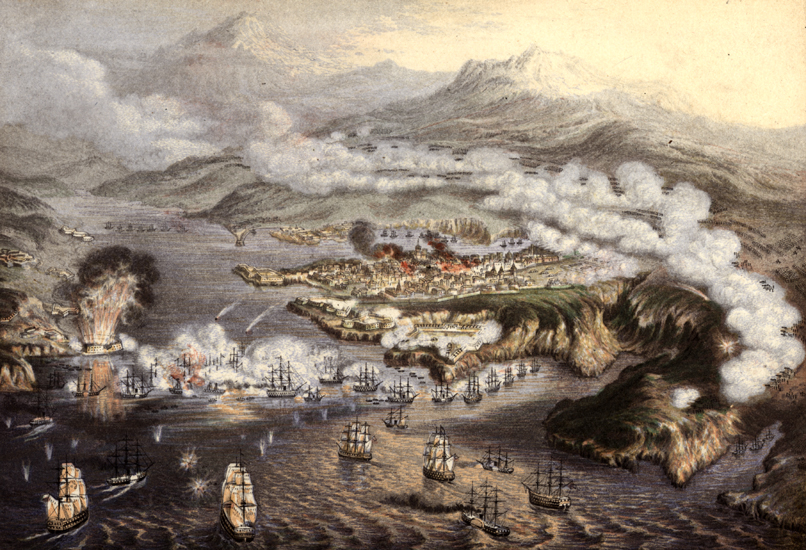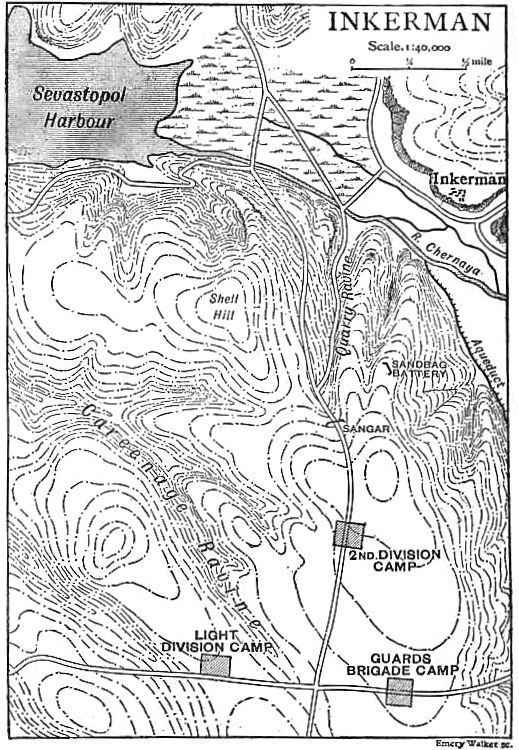|
William Codrington (British Army Officer)
General Sir William John Codrington, (26 November 1804 – 6 August 1884) was a British Army officer and politician who served in the Crimean War. Military career He was the second son of Admiral Sir Edward Codrington, the victor of the Battle of Navarino. He was born on 26 November 1804. He entered the army as an ensign in the Coldstream Guards in 1821, and was promoted lieutenant in 1823, lieutenant and captain in 1826, major and lieutenant colonel in 1836, and colonel in 1846, and throughout that period had never been on active service. He found himself at Varna in the summer of 1854, when the English and French armies were encamped there, either as a mere visitor and colonel unattached, as Kinglake says, or in command of the battalion of Coldstream guards, when his promotion to the rank of major general was gazetted on 20 June 1854. As a general officer on the spot, he was requested by Lord Raglan to take command of the 1st Brigade of the Light Division, consisting of the ... [...More Info...] [...Related Items...] OR: [Wikipedia] [Google] [Baidu] |
Heckfield
Heckfield is a village in Hampshire, England. It lies between Reading and Hook. It is the location of Highfield Park, where Neville Chamberlain died in 1940, and it is adjacent to Stratfield Saye House Stratfield Saye House is a large stately home at Stratfield Saye in the north-east of the English county of Hampshire. It has been the home of the Dukes of Wellington since 1817. Early history The line of the Roman Road the Devil's Highway ( ..., the large stately home that has been the home of the Dukes of Wellington since 1817. It is now a hotel and venue facility. References Further reading * W. J. James ''History of Heckfield and Mattingley'' External links Villages in Hampshire {{Hampshire-geo-stub ... [...More Info...] [...Related Items...] OR: [Wikipedia] [Google] [Baidu] |
Richard Airey, 1st Baron Airey
General Richard Airey, 1st Baron Airey, (April 180314 September 1881), known as Sir Richard Airey between 1855 and 1876, was a senior British Army officer of the 19th century. Background Born at Newcastle upon Tyne, Northumberland, Airey was the eldest son of Lieutenant General Sir George Airey and his wife Catherine Talbot, daughter of Richard Talbot and Margaret Talbot, 1st Baroness Talbot of Malahide. Military career Airey was educated at the Royal Military College, Sandhurst, and entered the army as an ensign of the 34th (Cumberland) Regiment of Foot in 1821. He became captain in 1825, and served as aide-de-camp on the staff of Sir Frederick Adam in the Ionian Islands (1827–1830) and on that of Lord Aylmer in North America (1830–1832). In 1838 Airey, then a lieutenant colonel, went to Horse Guards as assistant adjutant-general. In 1847, he was appointed assistant quartermaster-general, an appointment he retained until 1851. From 1852 to 1854 he was Military Secr ... [...More Info...] [...Related Items...] OR: [Wikipedia] [Google] [Baidu] |
Governor Of Gibraltar
The governor of Gibraltar is the representative of the British monarch in the British overseas territory of Gibraltar. The governor is appointed by the monarch on the advice of the British government. The role of the governor is to act as the ''de facto'' head of state. They are responsible for formally appointing the chief minister of Gibraltar, along with other members of the government of Gibraltar after a general election. The governor serves as commander-in-chief of Gibraltar's military forces and has sole responsibility for defence and security. Although recent appointments have all been former military personnel, most being former Royal Navy or Royal Marines flag officers, Sir James Dutton resigned from the role in 2015, complaining that it was "more representational and ceremonial than I had expected". The governor has his own flag in Gibraltar, the Union Flag defaced with the territory's coat of arms. However, at the governor's official residence ('' The Convent''), ... [...More Info...] [...Related Items...] OR: [Wikipedia] [Google] [Baidu] |
54th Regiment Of Foot
The 54th Regiment of Foot was an infantry regiment of the British Army, raised in 1755. Under the Childers Reforms it amalgamated with the 39th (Dorsetshire) Regiment of Foot to form the Dorsetshire Regiment in 1881. History Early history The regiment was raised in Salisbury by John Campbell, 5th Duke of Argyll in 1755 as the 56th Regiment of Foot for service in the Seven Years' War. It was re-ranked as the 54th Regiment of Foot, following the disbandment of the existing 50th and 51st regiments, in 1756. The regiment was deployed to Gibraltar in 1756 and remained there until it moved to Ireland in 1765.Records, p. 4 American Revolution The regiment was deployed to North America for service in the American Revolutionary War in 1776 and first saw action at the Battle of Sullivan's Island in June 1776.Records, p. 5 It went on to fight at the Battle of Long Island in August 1776, and the Battle of Rhode Island in August 1778. In May 1778 100 men of the 54th Regiment of Foot ... [...More Info...] [...Related Items...] OR: [Wikipedia] [Google] [Baidu] |
Siege Of Sevastopol (1854–1855)
The siege of Sevastopol (at the time called in English the siege of Sebastopol) lasted from October 1854 until September 1855, during the Crimean War. The allies (French, Sardinian, Ottoman, and British) landed at Eupatoria on 14 September 1854, intending to make a triumphal march to Sevastopol, the capital of the Crimea, with 50,000 men. Major battles along the way were Alma (September 1854), Balaklava (October 1854), Inkerman (November 1854), Tchernaya (August 1855), Redan (September 1855), and, finally, Malakoff (September 1855). During the siege, the allied navy undertook six bombardments of the capital, on 17 October 1854; and on 9 April, 6 June, 17 June, 17 August, and 5 September 1855. The Siege of Sevastopol is one of the last classic sieges in history. The city of Sevastopol was the home of the Tsar's Black Sea Fleet, which threatened the Mediterranean. The Russian field army withdrew before the allies could encircle it. The siege was the culminating struggl ... [...More Info...] [...Related Items...] OR: [Wikipedia] [Google] [Baidu] |
James Simpson (British Army Officer)
General Sir James Simpson (1792 – 18 April 1868) was a British Army officer of the 19th century. He commanded the British troops in the Crimea from June to November 1855, following the death of Field Marshal Lord Raglan. Simpson's competence in leading troops during the Crimean conflict was criticized by his contemporaries. Military career Educated at the University of Edinburgh, Simpson was commissioned into the 1st Regiment of Foot Guards on 3 April 1811. He served with his regiment during the Peninsular War and the Waterloo Campaign, and then commanded the 29th Regiment of Foot in Mauritius and Bengal. In 1839 Simpson married Elizabeth, daughter of Sir Robert Dundas, 1st Baronet of Beechwood. She died in 1840. Promoted to major general on 11 November 1851, he became General Officer Commanding the South-West District that same month. In February 1855 he was sent out to the Crimea to act as chief of staff to the army commander Lord Raglan. Raglan died on 28 June, and Simps ... [...More Info...] [...Related Items...] OR: [Wikipedia] [Google] [Baidu] |
Redan
Redan (a French word for "projection", "salient") is a feature of fortifications. It is a work in a V-shaped salient angle towards an expected attack. It can be made from earthworks or other material. The redan developed from the lunette, originally a half-moon-shaped outwork; with shorter flanks it became a redan. History Redans were a common feature in the coastal batteries built in Malta between 1715 and the end of the 18th century. Surviving batteries with redans include Mistra Battery and Saint Anthony's Battery. The Russians used redans on their left at the Battle of Borodino against Napoleon. A small redan whose faces make an obtuse angle with a vertex toward the enemy is called a '' flèche'' (arrow in French). The '' Bagration flèches'' were three redans backwards in echelon. The Shevardino Redoubt (another redan) was erected as an early warning post a mile in front of the Bagration flèches. The "Redan hole" in golf A ''Redan hole'' or ''Redan'' is an a ... [...More Info...] [...Related Items...] OR: [Wikipedia] [Google] [Baidu] |
Edwin Markham (British Army Officer)
Lieutenant-General Sir Edwin Markham (28 March 1833 – 1 April 1918) was a British Army officer who became Lieutenant Governor of Jersey in 1892. Early life Markham was born in Aberford, Yorkshire on 28 March 1833, the son of Colonel William Markham and Lucy Anne Markham. Military career Markham was educated at the Royal Military Academy, Woolwich. He passed out and Commissioned officer, commissioned into the Royal Artillery in 1850 Markham served in the Crimean War."Death of Sir Edwin Markham." Times [London, England] 2 April 1918: 3. The Times Digital Archive. Web. 31 December 2015. Markham served the Eastern campaign of 1854, and up to January 1855, including the affair of M'Kenzie's Farm, the Battle of Alma and the Battle of Inkerman, the Siege of Sevastopol (1854–55), Siege of Sevastopol and repulse of the Russian sortie on 26 October 1854 (he was awarded the medal with three clasps, appointed a Knight of the Legion of Honor and awarded the Turkish Medal). In 1855, he ... [...More Info...] [...Related Items...] OR: [Wikipedia] [Google] [Baidu] |
Knight Commander Of The Order Of The Bath
The Most Honourable Order of the Bath is a British order of chivalry founded by George I on 18 May 1725. The name derives from the elaborate medieval ceremony for appointing a knight, which involved bathing (as a symbol of purification) as one of its elements. The knights so created were known as "Knights of the Bath". George I "erected the Knights of the Bath into a regular Military Order". He did not (as is commonly believed) revive the Order of the Bath, since it had never previously existed as an Order, in the sense of a body of knights who were governed by a set of statutes and whose numbers were replenished when vacancies occurred. The Order consists of the Sovereign (currently King Charles III), the Great Master (currently vacant) and three Classes of members: *Knight Grand Cross ( GCB) ''or'' Dame Grand Cross ( GCB) *Knight Commander ( KCB) ''or'' Dame Commander ( DCB) *Companion ( CB) Members belong to either the Civil or the Military Division.''Statutes'' 1925, a ... [...More Info...] [...Related Items...] OR: [Wikipedia] [Google] [Baidu] |
Battle Of Inkerman
The Battle of Inkerman was fought during the Crimean War on 5 November 1854 between the allied armies of Britain and France against the Imperial Russian Army. The battle broke the will of the Russian Army to defeat the allies in the field, and was followed by the siege of Sevastopol. The role of troops fighting mostly on their own initiative due to the foggy conditions during the battle has earned the engagement the name "The Soldier's Battle." Prelude to the battle The allied armies of Britain, France, Sardinia, and the Ottoman Empire had landed on the west coast of Crimea on 14 September 1854, intending to capture the Russian naval base at Sevastopol. The allied armies fought off and defeated the Russian Army at the Battle of Alma, forcing them to retreat in some confusion toward the River Kacha. While the allies could have taken this opportunity to attack Sevastopol before Sevastopol could be put into a proper state of defence, the allied commanders, British general Fit ... [...More Info...] [...Related Items...] OR: [Wikipedia] [Google] [Baidu] |




